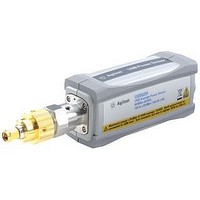U2001H AGILENT TECHNOLOGIES, U2001H Datasheet - Page 6

U2001H
Manufacturer Part Number
U2001H
Description
USB POWER SENSOR, 6GHZ, -50DBM To +30DBM
Manufacturer
AGILENT TECHNOLOGIES
Datasheet
1.U2001A.pdf
(23 pages)
Specifications of U2001H
Frequency Measuring Range
10MHz To 6GHz
Amplitude Accuracy
± 4%
Standing Wave Ratio
1.15
Connector Type
N
External Height
36mm
External Width
46mm
External Depth
207mm
Weight
0.324kg
Lead Free Status / RoHS Status
na
Take a Closer Look
Built-in triggering port for
synchronization with external
instruments or events
Diode-based sensors frequently
rely on the application of correction
factors to extend their dynamic range
beyond their square-law region, typi-
cally in the range of –70 to –20 dBm.
While this technique achieves
measurement of CW signals over
a wide dynamic range, it fails to do
so for modulated signals when the
signal level is above the square-law
region. Modulated signals must be
padded down, with their average and
peak power levels within the diode
square-law region, for accurate aver-
age power measurement.
The U2000 Series USB power sensors
are true-average, wide-dynamic-range
RF/microwave power sensors,
based on a dual-sensor diode pair/
attenuator/diode pair topology as
proposed by Szente et. al. in 1990
1. US Patent #4943764, assigned to Hewlett-Packard Company
2. November 1986 Hewlett-Packard Journal pages 14-2, “Diode Integrated Circuits for Millimeter-Wave Applications”
3. Refer to “Maximum Power” on page 9 for maximum power handling specifications
Small and lightweight build
1
.
The simplified block diagram shown
here illustrates this technique.
RF in
This technique ensures diodes in the
selected signal path are kept in their
square law region—with output cur-
rent and voltage proportional to input
power. The diode pair/attenuator/
Secure locking mechanism
6
LED indicator for PC communication
Low Sense +
Low Sense –
High Sense +
High Sense –
diode pair assembly can then yield
the average of complex modulation
formats across a wide dynamic range,
irrespective of signal bandwidth.
The dual-range Modified Barrier
Integrated Diode (MBID)
incorporates diode stacks in place of
single diodes. This further improves
measurement accuracy of high-level
signals with high crest factors with-
out incurring damage
Implementation of both techniques in
the U2000 Series USB sensors enable
effective average power measure-
ments of a wide range of signals,
including multitone and spread spec-
trum signals used in CDMA, W-CDMA
and digital television sytems.
USB 2.0-compliant cable
for connection to PC or
other instruments
3
to the sensor.
2
package










